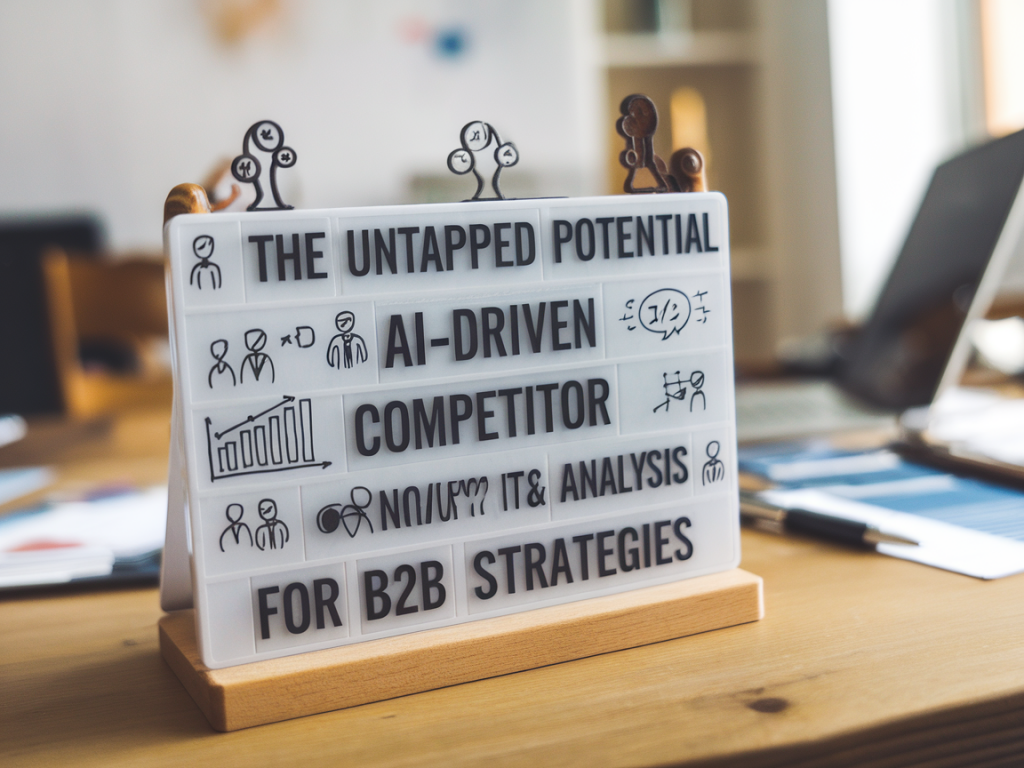
In the highly competitive landscape of B2B industries, the companies that rise above the rest are those that not only understand their market but also anticipate their competitors' next moves. And as artificial intelligence (AI) evolves, it presents a paradigm-shifting opportunity for businesses to transform how they approach competitor analysis. AI-driven competitor analysis isn't just a cool tech trend—it’s an untapped goldmine waiting to redefine B2B strategies.
What is AI-Driven Competitor Analysis?
At its core, AI-driven competitor analysis leverages advanced technologies to gather, process, and interpret data about your competitors faster and more accurately than any human team ever could. This includes crunching financial reports, tracking market share, analyzing digital marketing strategies, or even evaluating customer sentiment.
Unlike manual competitor analysis—which is time-consuming and often prone to human bias—AI algorithms can sift through massive volumes of data from multiple sources, including social media platforms, search engines, online reviews, and public records. Tools such as Crayon, Crystalknows, and industry-specific AI platforms are empowering businesses to act on real-time data with unprecedented precision.
Why AI-Driven Competitor Analysis is Perfect for B2B Strategies
The B2B space thrives on complexity. Here, decision-making isn’t always a straight line. B2B buyers, for instance, often have longer sales cycles, multiple touchpoints, and very specific pain points. This is where AI competitor insights shine, transforming complex processes into streamlined action. Here are some clear benefits:
- Improved Market Understanding: Whether it’s pricing tactics, product launches, or customer acquisition strategies, AI helps you spot trends in your competitors’ behavior that would otherwise go unnoticed.
- Predictive Competitive Intelligence: AI doesn’t just monitor your competitors’ current strategies—it uses historical data and pattern analysis to predict their future moves.
- Faster Decision-Making: In B2B, time is often critical in capitalizing on opportunities. AI tools enable faster and more accurate decisions, leaving no room for vague assumptions.
- Enhanced Personalization: In a space where relationships matter, understanding what your competitors offer to similar clients allows you to customize your approach and stand out.
Transforming Real-Time Feedback into Actionable Data
One often-overlooked potential of AI in competitor analysis is its ability to assess sentiment. For instance, tools like Brandwatch and Talkwalker can monitor online discussions, ratings, and social feeds mentioning your competitors. Are their customers dissatisfied with certain experiences? Are they enthusiastic about a specific feature? These platforms process millions of conversations to offer clear, actionable findings.
Let’s take an example from the SaaS industry. Imagine you work for a B2B software provider, and your AI tool identifies that customers of a competitor are often frustrated with the complexity of its UI. This insight allows you to create marketing campaigns emphasizing your platform's user-friendly features, while your competitors scramble to respond.
How to Integrate AI Competitor Analysis into Your Strategy
Incorporating AI into your competitor analysis doesn’t have to be overwhelming. Here’s how you can get started:
- Choose the Right Tools: Depending on your industry, AI software tailored to your unique needs will offer the best results. Tools like SimilarWeb for web analytics or SEMrush for keyword monitoring are excellent starting points.
- Define Key Metrics: Before diving into any analysis, determine what you want to measure—market share, sentiment scores, pricing benchmarks, or digital ad strategies, for example.
- Set a Monitoring Schedule: AI monitoring should be dynamic. Regular tracking and real-time alerts help spot changes as they occur.
- Collaborate Across Departments: AI-driven insights are most powerful when shared across teams, from sales to product development.
- Focus on Ethical Boundaries: Always work within industry regulations and guidelines. Stay transparent while gathering data to ensure compliance with data privacy norms.
The Role of AI Competitor Analysis in Rethinking Your Value Proposition
Imagine this: Through AI-powered tools, you discover your largest competitor has just implemented environmental sustainability efforts into their operations, winning significant traction from environmentally-conscious buyers. This knowledge could prompt you to integrate similar initiatives—or find an even better way to differentiate your brand. Insights like these are invaluable for refining your value proposition and adapting it to current market demands.
For example, Nike, through its dedicated innovation lab, uses AI to study competitors not only in the sportswear sector but also brands active in technology and lifestyle. This cross-sector intelligence approach helps them stay ahead of trends by anticipating shifts in buyer needs, such as the increasing demand for AR/VR integrations into product experiences.
Overcoming Challenges in AI-Driven Competitor Analysis
No revolutionary tool comes without its challenges, and AI competitor analysis is no exception. Several barriers include:
- Data Accuracy: Though automated, your AI analysis is only as reliable as the data it collects. Regularly audit to ensure false positives or skewed patterns aren’t compromising the insights.
- Integration Complexity: Synchronizing AI tools with existing systems like CRM and marketing platforms can overwhelm teams if not approached strategically.
- Over-reliance on AI: While incredibly accurate, AI shouldn’t replace your human team. Strategic thinking and market expertise remain essential for nuanced decision-making.
The good news? These challenges have solutions. Partnering with experts, providing thorough training programs for employees, and continuously updating your AI tools can eliminate most hurdles.
Final Thought: AI as a Gateway to Innovation
AI-driven competitor analysis is less about chasing your competitors and more about using them as a lens for self-improvement. It allows businesses to fine-tune their strategies, uncover new opportunities, and harness the power of agility—qualities all B2B companies need to thrive in an unpredictable market.
The B2B world is no longer just about outpacing your rivals; it’s about creating better value, solving complex problems, and doing so faster than ever before. And with AI on your side, this goal is more attainable than you think.

